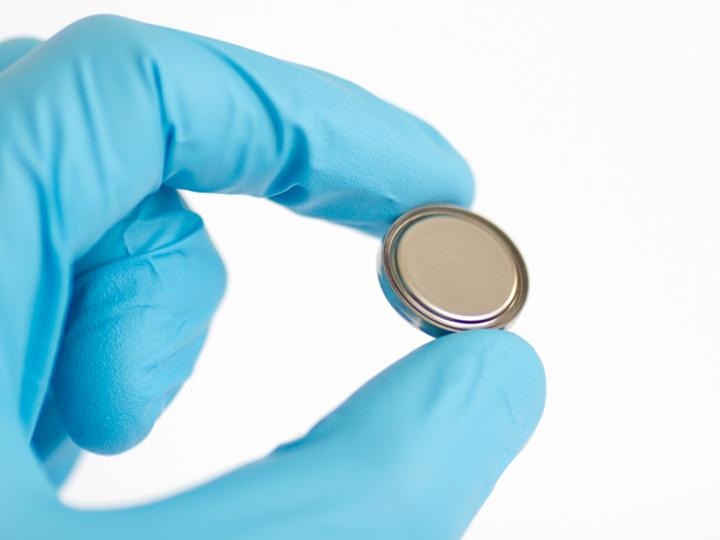May 1 2018
Inexpensive batteries may be possible using a new conductor material and a new electrode material, which then could result in large-scale storage of renewable energies.
 The researchers produced aluminum button cells in the laboratory. The battery case is made of stainless steel coated with titanium nitride on the inside to make it corrosion resistant. (Image credit: ETH Zurich/Kostiantyn Kravchyk)
The researchers produced aluminum button cells in the laboratory. The battery case is made of stainless steel coated with titanium nitride on the inside to make it corrosion resistant. (Image credit: ETH Zurich/Kostiantyn Kravchyk)
Energy transition relies on technologies that allow the economical temporary storage of electricity from renewable sources. A favorable new candidate is aluminum batteries, which are made from inexpensive and abundant raw materials.
Researchers from ETH Zurich and Empa - led by Maksym Kovalenko, Professor of Functional Inorganic Materials - are among those involved in exploring and designing batteries of this kind. The researchers have currently identified two new materials that could transform the development of aluminum batteries. The first is a corrosion-resistant material meant for the battery’s conductive parts; the second is a unique material for the battery’s positive pole that can be modified to a wide variety of technical requirements.
Aggressive Electrolyte Fluid
As the electrolyte fluid in aluminum batteries is very aggressive and corrodes stainless steel, and even platinum and gold, researchers are hunting for corrosion-resistant materials for the battery’s conductive parts. Kovalenko and his colleagues have located what they were seeking in titanium nitride, a ceramic material that displays adequately high conductivity.
“This compound is made up of the highly abundant elements titanium and nitrogen, and it’s easy to manufacture,” explains Kovalenko.
The researchers have successfully built aluminum batteries with conductive parts composed of titanium nitride in the laboratory. The material can easily be made in the form of thin films. It can also be used as a coating over other materials such as polymer foils. Kovalenko is certain that it would also be possible to make the conductors from a conventional metal and apply a coating of titanium nitride on them, or even to print conductive titanium nitride tracks on to plastic.
The potential applications of titanium nitride are not limited to aluminum batteries. The material could also be used in other types of batteries; for example, in those based on magnesium or sodium, or in high-voltage lithium-ion batteries
Maksym Kovalenko, Professor of Functional Inorganic Materials
An Alternative to Graphite
The second new material can be employed in the positive electrode (pole) of aluminum batteries. Here, the negative electrode in these batteries is composed of aluminum and the positive electrode is typically made of graphite. At present, Kovalenko and his team have discovered a new material - polypyrene that rivals graphite with regards to the amount of energy a battery is capable of storing. Polypyrene is a hydrocarbon with a chain-like (polymeric) molecular structure. In experiments, samples of the material - mainly those in which the molecular chains congregate in a haphazard manner - proved to be perfect.
“A lot of space remains between the molecular chains. This allows the relatively large ions of the electrolyte fluid to penetrate and charge the electrode material easily,” Kovalenko explains.
One of the benefits of electrodes comprising polypyrene is that the researchers are able to manipulate their properties, such as the porosity. The material can thus be adapted flawlessly to the specific application.
"In contrast, the graphite used at present is a mineral. From a chemical engineering perspective, it cannot be modified,” says Kovalenko.
As both polypyrene and titanium nitride are flexible materials, the scientists believe they are ideal for use in “pouch cells” (batteries placed within a flexible film).
Batteries for the Energy Transition
More and more electricity is produced from wind and solar energy. Nevertheless, as electricity is needed even when the wind is not blowing and the sun is not shining, new technologies will be necessary, such as new types of batteries, to store this electricity in a profitable manner. Although present lithium-ion batteries are perfect for electromobility because of their low weight, they are also relatively expensive and thus unsuitable for economical mass stationary power storage.
Additionally, lithium is a comparatively rare metal and is hard to extract—in contrast to aluminum, sodium, or magnesium. Batteries based on one of the latter three elements are therefore viewed as a favorable option for stationary power storage in the future. However, such batteries are still in the research phase and have still not entered industrial use.